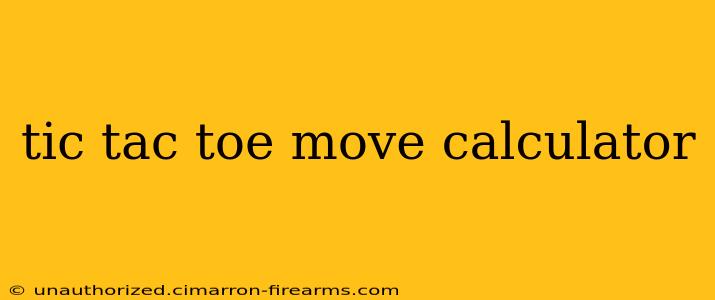Tic-tac-toe, despite its simplicity, offers a fascinating arena for exploring game theory and optimal strategies. While a perfect game from both players always results in a draw, understanding how to calculate the best move can significantly improve your gameplay and, more importantly, help you avoid losing. This guide dives deep into creating a tic-tac-toe move calculator, explaining the underlying logic and providing practical examples.
Understanding the Tic-Tac-Toe Game Tree
The core of any tic-tac-toe move calculator lies in understanding the game tree. This is a visual representation of all possible game states, branching from the initial empty board to all possible winning, losing, or drawn scenarios. Because tic-tac-toe has a relatively small number of possible moves, the entire game tree can be easily mapped.
Key Concepts for Calculation:
-
Minimax Algorithm: This is a fundamental algorithm in game theory that helps determine the optimal move for a given player. It explores the game tree, assigning values to each node representing the outcome (win, loss, or draw) from the perspective of the player. The algorithm then backtracks, choosing the move that maximizes the player's chances of winning or minimizes their chances of losing.
-
Heuristics: For more complex games, heuristics are often used to guide the search through the game tree, pruning branches that are less likely to lead to a favorable outcome. In tic-tac-toe, this isn't strictly necessary due to the game's simplicity, but it could be incorporated for efficiency in larger game trees.
-
Board Representation: The first step in building a calculator is to choose a way to represent the game board. This can be a 3x3 array, a list of 9 elements, or even a string. The choice impacts the efficiency and clarity of the code.
Building a Simple Tic-Tac-Toe Move Calculator
A basic calculator can be implemented using a combination of the minimax algorithm and a simple board representation. Here's a conceptual outline:
-
Board Representation: Use a 3x3 array (list of lists in Python) where each element represents a cell: 0 (empty), 1 (player X), or -1 (player O).
-
Minimax Implementation: Recursively explore the game tree. At each node:
- Base Cases: Check for a win or draw. If a win is found, return a score (e.g., +1 for X, -1 for O, 0 for a draw).
- Recursive Step: Generate all possible moves for the current player. Recursively call the minimax function on each resulting board state. Choose the move that maximizes the score for the maximizing player (X) and minimizes the score for the minimizing player (O).
-
Move Selection: The minimax algorithm returns the best move for the current player.
Advanced Considerations:
-
Alpha-Beta Pruning: This optimization technique significantly speeds up the minimax algorithm by eliminating branches that are guaranteed to be worse than already explored options.
-
Monte Carlo Tree Search (MCTS): For more complex games, MCTS provides a probabilistic approach to exploring the game tree, focusing on promising branches. While not strictly necessary for tic-tac-toe, it's a valuable technique to understand for more challenging games.
-
User Interface: Creating a user-friendly interface allows for easy interaction with the calculator, making it more accessible and engaging.
Conclusion: Beyond the Basics
While a basic tic-tac-toe move calculator is relatively straightforward to implement, understanding the underlying algorithms—like the minimax algorithm and its optimizations—provides a foundation for tackling more complex games. The principles discussed here extend far beyond tic-tac-toe, offering a valuable insight into the world of game AI and strategic decision-making. Building and experimenting with different implementations will solidify your understanding and showcase the power of algorithmic problem-solving.

